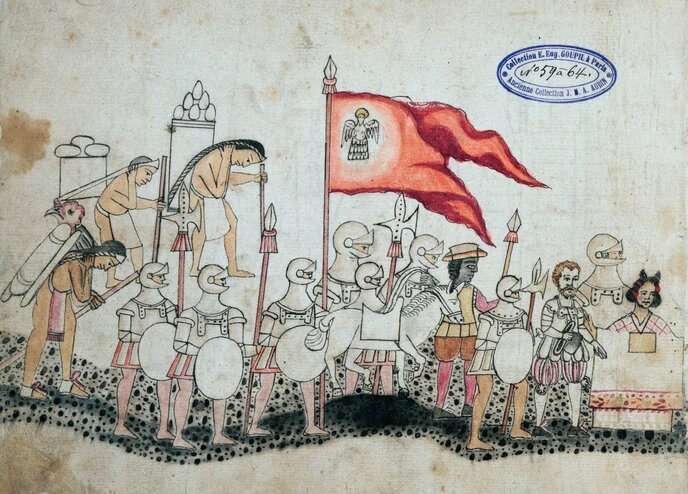16th or 17th century indigenous pictorial manuscript of the conquest of Mexico. Credit: Public domain
The transatlantic slave trade may have introduced new pathogenic viruses from Africa to North America that affected Indigenous communities, shows an analysis of ancient DNA published in eLife.
The findings suggest that European colonists brought new viruses, including smallpox, measles and mumps, to North America, which caused outbreaks that led to major population declines in Native American communities. This discovery adds new information about the legacy of the transatlantic slave trade in North America.
"Multiple outbreaks in what is now Mexico killed millions of Indigenous people, Africans and some Europeans in the 16th century. But the exact pathogens responsible for some of these outbreaks is not currently known," explains first author Axel Guzmán-Solís, a former student at the International Laboratory for Human Genome Research, Universidad Nacional Autónoma de México, Mexico, and who is now a Ph.D. student at the Icahn School of Medicine at Mount Sinai, New York, US. "We wanted to understand what viruses were circulating in Mexico during this period."
To do this, Guzmán-Solís and the team extracted ancient viral DNA from the teeth of probable victims of these outbreaks buried at a Colonial-era hospital and chapel. They included victims who were Indigenous as well as those who were of African descent. The team then used this DNA to reconstruct the genomes of viruses present in those samples. This allowed them to identify ancient human hepatitis B virus and human B19 parvovirus from different individuals. By comparing these virus' genomes to others, they found that the viruses likely originated in Africa.
"Our results suggest that the viruses were introduced to the Americas by colonists engaged in the slave trade," says co-senior author Daniel Blanco-Melo, a former postdoctoral researcher at the Icahn School of Medicine at Mount Sinai in New York who is now an Assistant Professor at the Fred Hutchinson Cancer Research Center in Seattle, U.S. "The cruel, unsanitary and overcrowded conditions on the ships that transported millions of people across the Atlantic was a favorable setting for the spread of infectious diseases. Therefore, this gruesome practice likely introduced new pathogens to Indigenous people who had no immunity to them." He adds that the conditions that colonists forced Africans and Native Americans to live in during this time would have also promoted the spread of the diseases and may have fueled epidemics.
The study is not able to determine whether these individuals were infected in Africa, during the forced transport, or if the viruses occurred after the Africans' arrival in North America. It is also unable to say whether the viruses caused the victims' deaths. But it does provide evidence that these viruses, which can cause serious disease, were circulating in the affected populations.
"Our findings also suggest that multiple, newly introduced viruses were circulating at the same time, which may explain why the epidemics proved so deadly for Indigenous communities," says co-senior author Maria Ávila-Arcos, Principal Investigator at the International Laboratory for Human Genome Research, Universidad Nacional Autónoma de México. "Together, this work demonstrates how the new field of paleovirology can help us learn more about the possible role of these and other pathogens in colonial epidemics and better understand the role of human actions in spreading them."
More information: Axel A Guzmán-Solís et al, Ancient viral genomes reveal introduction of human pathogenic viruses into Mexico during the transatlantic slave trade, eLife (2021). DOI: 10.7554/eLife.68612
Journal information: eLife
Provided by eLife
























